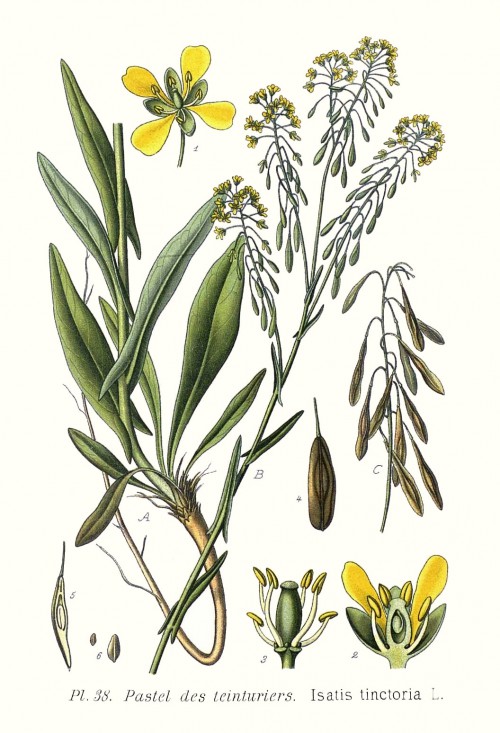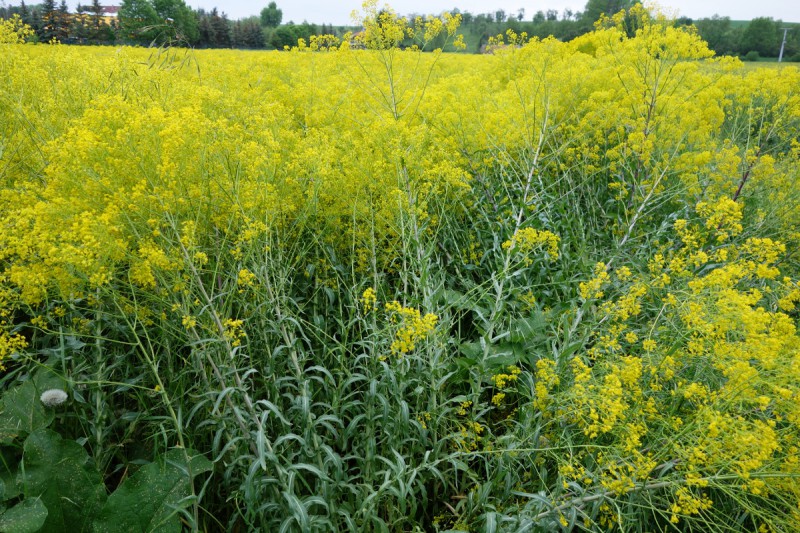Dies ist eine alte Version des Dokuments!
Isatis tinctoria L. - Brassicaceae - woad, Färberwaid
Bienniel herb, native to Europe, naturalized in Asia, cultivated elsewhere.
„ Isatis tinctoria is a European and probably Asian species very polymorphic in fruit shape, shape and size of auricles of cauline leaves, and the amount of indumentum. It has been cultivated since ancient times as a source of a dark blue dye (woad) obtained by fermenting the leaves and lower portions of the plant. Glabrous forms with oblong fruit and poorly developed or obtuse leaf auricles have been recognized as I. indigotica. By contrast, glabrous or hairy forms with cuneiform or oblong-triangular fruit and well-developed, often acute leaf auricles are called I. tinctoria. However, every conceivable morphological intermediate between the two forms occurs in China, as well as elsewhere in Asia, Europe, and North America, where they are introduced and naturalized.
The roots and leaves are used for medicinal purposes and a source of dye, and the seed oil is used in industry.“
http://www.efloras.org/florataxon.aspx?flora_id=2&taxon_id=200009571
„The dye chemical extracted from woad is indigo, the same dye extracted from „true indigo“, Indigofera tinctoria, but in a lower concentration….
Indigowoad Root (Chinese: 板藍根; pinyin: bǎn lán gēn) is a traditional Chinese medicine herb that comes from the roots of woad.“
http://en.wikipedia.org/wiki/Isatis_tinctoria
„Bǎn lán gēn was very popular especially during the SARS epidemic in China, although an effect against the virus could not be detected.“
https://de.wikipedia.org/wiki/F%C3%A4rberwaid
„Woad seeds contain as much as 0.23% fresh weight of glucobrassicin but no other indole glucosinolate, while 1-week-old seedlings also contain substantial amounts of neoglucobrassicin and glucobrassicin-1-sulfonate in their shoots whether grown in the light or dark. The sulfonate is not found in roots, and light depresses neoglucobrassicin levels in shoots.“
[Distribution and variation of indole glucosinolates in woad (Isatis tinctoria L.)., Elliott, M.C., Stowe, B.B., Plant physiology, Vol.48(4), 1971, 498-503] http://www.plantphysiol.org/content/48/4/498.full.pdf
„Isatis tinctoria L. has, moreover, a well documented history of use as a medicinal herb, and it is commonly used in traditional Chinese medicine; root extracts of the herb are known as Bang Lang Gen and leaf extracts as Da Qing Ye. Documented medicinal use of Isatis in the western tradition extends back to at least the first century A.D.. Inflammatory conditions have been considered as the major indication for Isatis tinctoria L. leaf extracts; hence, the most recent researches on the active principles in woad deal with the presence of anti-inflammatory substances. In particular, the indolo[2,1-b]quinazoline alkaloid tryptanthrin has recently been identified as a pharmacologically active compound in Isatis tinctoria with potent dual inhibitory activity on prostaglandin and leukotriene synthesis…
In I.tinctoria 3-butenyl isothiocyanate prevailed (X= 376.1ppm); this agreed with Freichardet al. who identified in seeds of I.tinctoria the glucosinolate gluconapin whose aglycone is the 3-butenylisothiocyanate. The same authors identified the glucosinolates progoitrin and epiprogoitrin whose aglycone, 2-hydroxy-3-butenyl isothiocyanates, was moreover present in our samples at high amount (X= 110.5 ppm). 3-Methylthiopropyl isothiocyanate was moreover present (X= 4.7ppm); this component was identified by Cole at a similar level in I.tinctoria. Allyl isothiocyanate is less represented in I.tinctoria leaf although it is the main compound in different cultivars of Brassica oleracea such as broccoli and cauliflower. Among the sulfurated compounds a high amount of 2-ethylthiophene (X= 182.1 ppm) has been observed; the thiophenes are widely distributed in vegetables such as onion, their odour thresholds are very low and the flavour character very pronounced.“
[The leaf volatile constituents of Isatis tinctoria by solid-phase microextraction and gas chromatography/mass spectrometry., Condurso, C., Verzera, A., Romeo, V., Ziino, M., Trozzi, A., Ragusa, S., Planta medica, Vol.72(10), 2006, 924]
„The root volatiles in I. tinctoria were characterized by a high amount of 3-butenyl isothiocyanate, which accounted for about 82% of the total volatile fraction.“
[Volatile constituents in dried roots of Isatis tinctoria L.(Brassicaceae)., Verzera, A., Condurso, C., Dima, G., Ziino, M., Ragusa, S., Journal of Essential Oil Research, Vol.22(6), 2010, 483-485]
„… fresh flower buds were collected on Mount Etna slopes in Sicily over two years and analysed for their bioactive compound content. Woad samples contained considerable amounts of glucosinolates, ranging from 80 up to over 100 µmol/g d.w., which are values higher than those found in other Brassica vegetables. Only gluconapin and the most interesting glucobrassicin, which is the natural precursor of indole-3-carbinol, a multiple antitumorigenic compound, were found. High mean values were also recorded for total polyphenols and flavonoids (25 GAE mg/g d.w. and 7 CE mg/g d.w., respectively). Consequently, also the antioxidant activity (H-ORAC) of the woad flower buds resulted among the highest reported for other Brassica vegetables, being about 300 µmol TE/g d.w. Since processing can partly reduce the glucosinolate content of vegetables, different cooking ways, such as boiling and microwaving, were compared. Boiling for 10 min caused losses of 34% of total glucosinolates, while microwaving (10 min, 800 W) only reduced the glucosinolate amount by 3%. The results obtained suggest that woad flower buds could be considered as a functional food with possible chemopreventive properties.“
[Nutraceutical Value of Woad (Isatis tinctoria) Flower Buds of Ecotypes from Sicily, Italy. Galletti, S., Bagatta, M., Iori, R., Ragusa, L., Branca, F., & Argento, S., In VI International Symposium on Brassicas and XVIII Crucifer Genetics Workshop 1005, 2012, 349-353)]

Masclef, A., Atlas des plantes de France, vol.2 t.38 (1890)
http://plantgenera.org/species.php?id_species=559943

cultivated Isatis tinctoria , CC BY-SA 3.0, Author: Andreas Kraska
